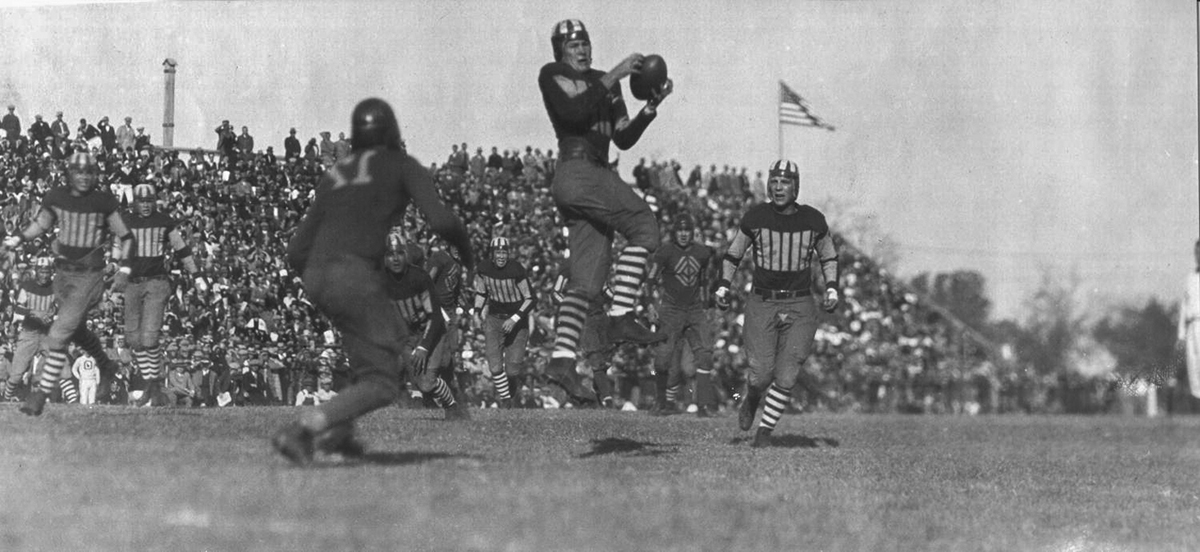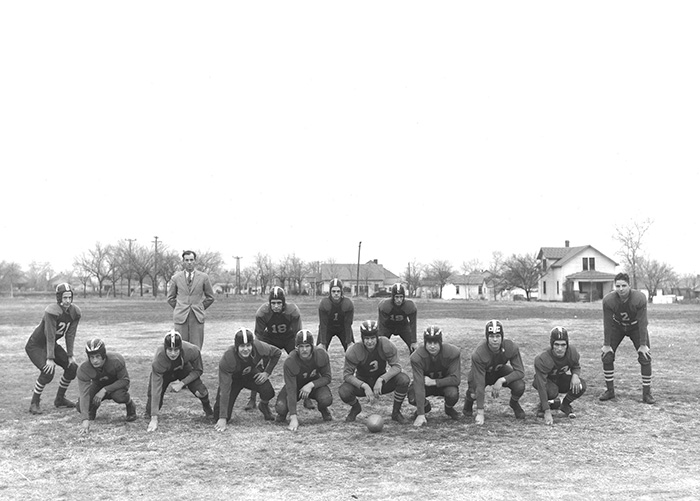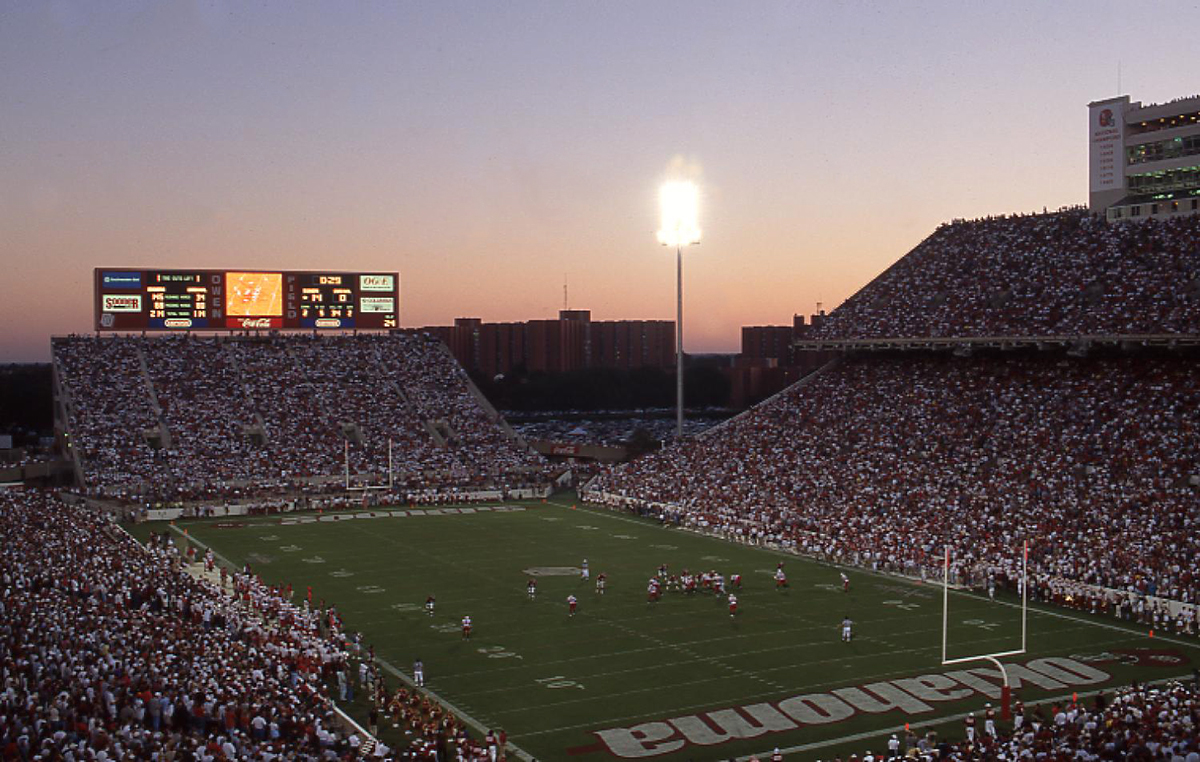FOOTBALL.
Scholar Michael Novak proclaims in The Joy of Sports, "nowhere, they say, is football more passionate and single-minded than in Texas and Oklahoma." The 1992 Atlas of American Sport declares that the Texas-Southwest, which includes Oklahoma and part of New Mexico, "is football country, first and foremost, [where] community pride and prestige are linked to the performance of the high school team." Novak and J. Steven Picou (writing in the Encyclopedia of Southern Culture) both point out that football in the South reflects the region's evangelical religious tradition and that football in the Midwest approximates the South's fervor but, like midwesterners' religious style and behavior, is more orderly and disciplined. Oklahoma serves as a crossroads of the southern and midwestern cultures. The population of the young state is mainly southern-bred in the south and east and midwestern in cultural origin in the north and west. These cultural constellations influence the passion for football that permeates the whole state. Two longtime powers are based in the different cultural regions: Ada in southeastern Oklahoma and Clinton in the west. Whether or not Novak's assertion about disciplined football is true, fanaticism abounds in both towns.
The sport of football, which developed in the Ivy League colleges of the northeast, was still evolving as young men in Indian and Oklahoma territories adopted the game. One of the first reported contests occurred in November 1894 between an Oklahoma City town team, the Terrors, and the local high school. Oklahoma City High School fielded a team the next year, beating the University of Oklahoma (OU). Soon, area high schools including Norman, El Reno, and Shawnee competed, playing area colleges, military teams, town teams, and preparatory schools, as well as Chilocco Indian Agricultural School. In the early twentieth century many of the larger towns in the state formed the Central Conference for high school competition.
In 1911 H. L. Hall of Shawnee led the organization of the Oklahoma High School Athletic Association (OHSAA), designed for the "betterment of athletics in the high schools of our state." The original members ranged from Lawton in the southwest corner to Bartlesville in the northeast and included Enid, Okmulgee, McAlester, and most of the larger towns. By 1927, 443 schools belonged, and in 1937, 712. The association enforced rules regarding eligibility for school sports: an interscholastic athlete must be under twenty-one, make passing grades, use his own real name, and never have been paid for sports. OHSAA also determined an athlete's years or semesters of eligibility.
OHSAA set guidelines to compare school records, but a state championship remained nonexistent. Various schools declared themselves "state champions"; Norman, Lawton, and Chickasha all legitimately claimed the title before 1911. In 1910 Chickasha not only commandeered the Oklahoma championship but also that of Texas and Kansas, having defeated the Texas state champ, Sherman, and winning over the Wichita, Kansas, champs by default. Not until 1944 did the OHSAA, which evolved into the Oklahoma Secondary School Activities Association (OSSAA), adopt a playoff system to determine a "true" champion. That year Oklahoma City Classen captured the state title for the largest class, and Garber and Lone Wolf won their respective smaller classes. In 1954 the OSSAA membership, believing the season lasted too long, voted against playoffs but reinstated them the next year.
Ada garnered its first championship of the playoff era in 1951 and by 2002 had won the title nineteen times. Clinton did not achieve a championship title until 1965, but by 2003 the school held twelve. Powerhouses measured by playoff championships through 2002 include Jenks (8), Thomas (8), Turpin (8), Oklahoma City Carl Albert (7), Tulsa Washington (6), and Morrison (9). African American schools and athletes began to compete in OSSAA playoffs after school integration in 1956. On November 3, 1955, in the state's first black-versus-white high school football game, eight thousand Oklahoma City fans watched Capitol Hill eke out a 13–6 victory over Douglass. Future Oklahoma Sooner Prentice Gautt starred for Douglass, and future Oklahoma State quarterback Dick Soergel led Capitol Hill. Douglass captured the 1956 championship. Between 1993 through 1996 Ada won forty-two straight games, to own the record for eleven-man football in Oklahoma, but eight-man juggernaut Morrison defeated ninety straight opponents from 1989 to 1995 to own a state and national record.
During the 1930s six-man football had a brief existence in scattered towns across the state and returned to the Panhandle in the early 1950s, before upgrading to the eight-man game. School consolidations in the 1960s enabled some towns to support football, but not traditional eleven-man, and therefore, the eight-man game spread throughout the state. Carmen won the first eight-man sanctioned championship in 1959. Many private Christian schools play this form of the sport. In 2001, 1,111 students participated, tying the state with Colorado for fifth-largest number of players in the nation.
Many Oklahoma colleges had strong teams at the beginning of the twentieth century. In 1895 OU's first team had a one-game schedule, losing to Oklahoma City High School. In 1897 Vernon L. Parrington coached the squad to nine wins, two losses, and one tie, in four years. In 1905 Bennie Owen took the reins. He won two conference championships in the Southwest Intercollegiate Athletic Association (SIAA). In 1915 Oklahoma joined the new Southwest Conference, winning championships in 1915 and 1918. In 1919 the school jumped to the Missouri Valley Conference and again won the first championship for which it was eligible. Owen's record stood at 128 wins, 52 losses, and 13 ties when he retired in 1926. His disciples filled many Oklahoma high school and college coaching positions. In 1927 OU again switched allegiances and became a charter member of the Missouri Valley Intercollegiate Athletic Association, or the Big Six Conference. The Sooners won the championship in 1938 and lost the 1939 Orange Bowl but won two more titles before the end of World War II.
In Stillwater the Oklahoma A&M Aggies (later Oklahoma State University [OSU] Cowboys) did not enjoy the success of OU. In 1899 A&M lost its first intercollegiate game to Kingfisher College. In 1901 A&M defeated Northwestern Normal of Alva, winning its first game. The 1908 squad, led by Ed Gallagher, was the first to have a winning record, four wins against three losses. Often during this early period, OU and A&M would play a Thanksgiving game in Oklahoma City. There in 1917 A&M defeated the Sooners for the first time in twelve tries. A&M joined the SIAA in 1914 and in 1924 entered the Missouri Valley Conference, winning the title in 1926. In 1929 A&M hired Lynn Waldorf, a former Syracuse player and Oklahoma City University coach. During five years he won thirty-four, lost ten, tied seven, won three conference titles, and never lost to Tulsa or Oklahoma. Waldorf took a job at Kansas State and later coached at Northwestern and the University of California. In 1966 the College Football Hall of Fame inducted him.
In the 1940s OSU coach Jim Lookabaugh harnessed one of the great periods of OSU football. Bob Fenimore, Neill Armstrong, and Ralph Foster led the team through a one-loss 1944 season capped with a Cotton Bowl victory on New Year's Day, 1945. In 1945 the team went undefeated, beating St. Mary's, California, in the 1946 Sugar Bowl. The team won the Missouri Valley Conference Championship in 1944 and 1945, walloped OU 41–0 in 1945 for the second straight time, and earned Fenimore (1944 and 1945) and Armstrong (1946) All-American honors. OSU ended the 1940s with a 1949 Delta Bowl victory. After one bowl appearance in the 1950s and two in the 1970s, OSU saw a resurgence in power in the 1980s. The 1978 hiring of Jimmy Johnson boosted the program despite NCAA probation. When Johnson left in 1984, assistant coach Pat Jones took the team to a ten-win season. In the 1980s six bowls invited the Cowboys to post-season games. The 1980s team produced great running backs, including Ernest Anderson, Thurman Thomas, and Heisman Trophy–winner Barry Sanders to add to past stars Fenimore (1946), Walt Garrison (1965), and Terry Miller (1977). With players Mike Gundy, Rusty Hilger, Dexter Manley, Leslie O'Neal, Cary Blanchard, and Hart Lee Dykes, the Cowboys finished five times in the top twenty-five. In the 1990s OSU consistently competed well against OU, winning three out of six to close the decade, breaking a losing streak begun in 1976.
Henry Kendall College, later the University of Tulsa, had a strong program in the early twentieth century. In 1895 the school played its first game, against Bacone Indian School. From 1900 until 1910 the college sporadically fielded teams, but by 1914 Kendall was an emerging power. The team played two undefeated seasons in 1916 and 1919, often burying opponents with scores such as 152–0 against Oklahoma Baptist and 117–0 versus the Missouri School of Mines. Kendall claimed to be state champion in 1916, beating OU and taking away an unofficial title the Sooners usually claimed. By 1924 known as the University of Tulsa, the school saw its Golden Hurricanes achieve another undefeated season. In the 1940s Tulsa found success under coach Henry Frnka and players Glenn Dobbs, Sax Judd, Ellis Jones, and Bobby Jack Stuart. The Hurricanes were invited to five straight New Year's Day Bowl games. Tulsa's 1950s teams included its first two-time All-American, Marvin Matuszak, and in the 1960s the team distinguished itself with a passing attack that broke numerous NCAA records. Coached by former star Dobbs, players Jerry Rhome, Howard Twilley, and then Billy Guy Anderson broke records, won games, and almost earned the Heisman Trophy, Rhome was the runner-up in 1964 and Twilley in 1965. From 1970 through 2000 Tulsa had a few good seasons, including a Missouri Valley championship in 1971 and 1974 and top-twenty-five finishes in 1982 and 1991, and produced NFL players, including Steve Largent and Drew Pearson.
Oklahoma City University (OCU) began playing football as Epworth University in 1905. Its 1909 team had a seven-and-one record, losing by one point to Oklahoma. They tied OU the next year, giving Phillips University an unofficial claim to the state title. OCU flourished under Lynn Waldorf in the 1920s, sharing the 1927 Oklahoma Collegiate Conference championship with Oklahoma Baptist University. OCU lost only one game in the first two seasons of the 1930s, relying on leaders Leroy Gutowsky, later of the Detroit Lions, Basil Wilkerson, Joe Rayburn Anderson, and Ted Hand. After World War II ended, OCU again had strong teams and played in the 1948 Glass Bowl in Toledo, Ohio. In 1949 financial problems ended the school's football program.
In the early twentieth century most Oklahoma colleges that could find enough willing students fielded a team. Kingfisher College, Phillips University, Southwestern Normal (later Southwestern Oklahoma State University), and Central State (later the University of Central Oklahoma) all had stretches with strong squads. Later many of these smaller Oklahoma colleges excelled in NAIA competition. The NAIA championship went to Northeastern State University in 1958 and 1994, UCO (as Central State) in 1962 and 1982, Cameron University in 1987, East Central University in 1993, Southwestern State University in 1996, and Northwestern State University in 1999.
After the University of Oklahoma hired Jim Tatum, on the condition that he bring Bud Wilkinson as his assistant, the Sooners became a college football powerhouse. After Tatum's single season Wilkinson took over in 1947. His coaching stint amassed two record-breaking undefeated streaks, one of thirty-one wins and a still-standing record of forty-seven victories. From the 1948 through the 1957 seasons he recorded ninety-seven wins, six losses, and two ties. The team attained three national championships. Success brought on a religious-style football fervor in a state that before had little self-esteem and had suffered from a stereotyped "poor Okie" self-image stemming from the Depression, the Dust Bowl, and out-migration. Kurt Burris, Jim Owens, Darrell Royal, Eddie Crowder, J. D. Roberts, Jim Weatherall, Buck McPhail, Max Boydston, Jimmy Harris, Buddy Leake, Jack Mitchell, Jerry Tubbs, Tommy McDonald, Prentice Gautt, and Heisman Trophy-winner Billy Vessels were a few of the stars of the Wilkinson era. In 1964 Wilkinson resigned.
From 1958 to 1965 a former OU player and coach of the University of Texas Longhorns, Darrell Royal, dominated the Sooners in one of the fiercest rivalries in football, played annually in the Dallas Cotton Bowl and known commonly as the Red River War. OU hired Jim Mackenzie for the 1966 season, and his staff included Chuck Fairbanks and Barry Switzer, laying the foundation for the next stage of the Sooners' national prominence. Mackenzie died after his first season, in which he beat Texas after an eight-year losing streak, and Chuck Fairbanks ascended to the head job. In 1969 Steve Owens became the second Sooner to win the Heisman Trophy. After the 1972 campaign Fairbanks left for professional football, and Barry Switzer took over.
Using the wishbone offense and relying on his ability to recruit African American players, Switzer won back-to-back national championships in his second and third year. In the 1970s he coached OU stars such as Lee Roy, Dewey, and Lucious Selmon, Joe Washington, Greg Pruitt, Rod Shoate, Scott Case, Kenny King, J. C. Watts, George Cumby, and the school's third Heisman winner, Billy Sims, and consistently beat rivals Texas and Nebraska. Although OU won the 1985 National Championship, Switzer resigned in 1989. Standouts of the 1980s included Jamelle Holieway, Brian Bosworth, Keith Jackson, Steve Sewell, Tony Casillas, and Ricky Dixon. In the 1990s OU slipped into mediocrity and even lower until the hiring of Bob Stoops in 1999. In 2000 his team won the university's seventh United Press International/Associated Press national championship, and as of 2020, the Sooners ranked third (with 7) behind Alabama (12) and Notre Dame (8). Stoops guided OU to ten conference titles and coached two Heisman winners, Jason White (2003) and Sam Bradford (2008). Stoops's successor, Lincoln Riley, garnered three titles and also coached Heisman winners Baker Mayfield (2017) and Kyler Murray (2018).
Oklahoma has had numerous semiprofessional and professional football teams. In 1932 the Oklahoma City Chiefs organized as a professional football team in Oklahoma City, playing Fort Sill in their first game. Baseball star Pepper Martin appeared in a few games in the Chiefs only season. In Hominy a team of American Indian football players, mainly from the Haskell School, organized a semipro team that played the Chiefs. In Tulsa the Oilers formed in 1966 and played in the Texas Professional Football League, played the 1967 season as the Thunderbirds, moved to Bartlesville as the Quickkicks, and folded. In 1974 the Tulsa Knights organized in the Mid-America League but disbanded in 1975. The Tulsa Mustangs played five games of a fifteen-game American Football Association (AFA) season before disbanding. In 1982 the Tulsa Thunder played in AFA but died when the city announced that it had attracted a United States Football League (USFL) team. In 1983 a San Diego team shifted to Tulsa as the Oklahoma Outlaws and signed Doug Williams, the first established NFL quarterback to move to the young league. In 1984 the team moved to Arizona. Oklahoma City later had numerous semipro and minor league teams with names such as Wranglers, Drillers, Mustangs, Golden Mustangs, Twisters, and Badboyz.
Two nontraditional professional football entities have played in three Oklahoma towns. The Tulsa Talons were an inaugural 2000 team for the Arena Football 2 League. The Oklahoma Wranglers of the Arena Football League called Oklahoma City home in 2000 and 2001 and folded. In 2003 the Oklahoma Crude began a schedule in Enid, playing in the National Indoor Football League. In 1976 the Oklahoma City Dolls won a co-championship in the National Women's Football League (NWFL) and won championships again in 1978 and 1979. Dormant in 1980 and 1981 the team disbanded before the 1982 season. In 1981 a movie titled The Oklahoma City Dolls portrayed the franchise. In 1977 the short-lived Tulsa Babes team joined the NWFL. At the turn of the twenty-first century Oklahoma women again sporadically began to play football with teams such as the Oklahoma City Lightning, Oklahoma City Wildcats, and Tulsa Tornadoes.
Even before the rise of the OU football powerhouse after World War II, Oklahoma had contributed to the game of football. The young state produced Jim Thorpe, who was a two-time All-American at Carlisle and was elected as the first president of the National Football League. Another Oklahoman, Steve Owen, a standout at Phillips University, went on to become an innovative coach for the New York Giants, and many credit his umbrella pass defense as a forerunner to the modern zone defense. It seems Oklahoma and football have grown up together, from early rough-and-tumble beginnings to a more refined but still hardened present. Oklahomans still idolize their football warriors on Friday nights and Saturday afternoons. Baseball and basketball have significant traditions in the state, but football provides an identity, internally and nationally, that for many residents symbolizes Oklahoma.
See Also
BASEBALL, BASKETBALL, RECREATION AND ENTERTAINMENT, SPORTS, WRESTLING
Bibliography
J. Brent Clark, Sooner Century: 100 Glorious Years of Oklahoma Football, 1895–1995 (Coal Valley, Ill.: Quality Sports Publications, 1995).
Doris Dellinger, A History of the Oklahoma State University Intercollegiate Athletics (Stillwater: Oklahoma State University, 1987).
Wilton D. Johnson, "The Organization and Operation of the Oklahoma High School Athletic Association" (Ph.D. diss., University of Oklahoma, 1942).
Harold Keith, Oklahoma Kickoff: An Informal History of the First 25 Years of Football at OU (Norman, Okla.: Harold Keith, 1948).
Robert Rutland, The Golden Hurricane: Fifty Years of Football at the University of Tulsa, 1895–1945 (Tulsa, Okla.: Tulsa Quarterback Club, 1952).
Berry Wayne Tramel, "The Significance of Sports in Oklahoma," in The Culture of Oklahoma, ed. Howard Stein and Robert Hill (Norman: University of Oklahoma Press, 1993).
Citation
The following (as per The Chicago Manual of Style, 17th edition) is the preferred citation for articles:
Larry O'Dell, “Football,” The Encyclopedia of Oklahoma History and Culture, https://www.okhistory.org/publications/enc/entry?entry=FO015.
Published January 15, 2010
Last updated
February 3, 2021
© Oklahoma Historical Society




